How Do You Know if Child Broken Nose
Contents
- Broken nose
- Cleaved olfactory organ complications
- The nose
- How to tell if your nose is broken
- What causes a broken nose?
- Risk factors for a cleaved nose
- How can I prevent a broken nose?
- Cleaved nose signs and symptoms
- Cleaved nose diagnosis
- Cleaved olfactory organ treatment
- Broken nose First Aid
- How to fix a cleaved nose
- Treating a astringent broken olfactory organ in hospital
- Broken nose surgery
Broken nose
A broken nose, too called a nasal fracture can affect both bone and cartilage (encounter Figures 1 to 4). A collection of blood (called a "septal hematoma") tin can sometimes form on the nasal septum (a wall fabricated of bone and cartilage inside the nose that separates the sides of the nose) (see Effigy 3). However, the term "broken nose," in most cases, refers to harm to the septal cartilage rather than the nasal bones themselves.
Common causes of a cleaved nose include contact sports, concrete fights, falls and motor vehicle accidents that result in facial trauma. A cleaved nose can cause pain, along with swelling and bruising around your nose and nether your optics. Your nose may look crooked, and you may take trouble breathing.
Handling for a broken nose may include procedures that realign your nose. Surgery usually isn't necessary for a broken olfactory organ.
A broken nose usually heals on its own within 3 weeks. Go medical help if it's not getting improve or your nose has inverse shape.
When to come across a doctor
- a nosebleed that won't stop
- a large open up wound on your nose – or something else still in the wound, such as glass
- clear, watery fluid trickling from your nose – this could be a sign of a serious head injury
- a astringent headache with blurred or double vision
- eye hurting and double vision
- neck pain or a stiff neck – with numbness or tingling in your artillery
- a blood clot in the peel between your nostrils (septum) – it may be painful, swollen or cake your breathing
- other symptoms of a severe head injury – such equally collapsing (passing out) or difficulty speaking
- your nose is crooked (non straight) after the injury
- the swelling hasn't started to go downwardly subsequently 3 days
- painkillers aren't helping
- y'all're still finding it hard to breathe through your nose after the swelling has gone
- y'all're having regular nosebleeds
- you have a very high temperature (or you feel hot and shivery)
- y'all take a large cut on your face
Broken nose complications
Complications or injuries related to a cleaved nose may include:
- Deviated septum. A olfactory organ fracture may cause a deviated septum, a condition that occurs when the thin wall dividing the ii sides of your nose (nasal septum) is displaced, narrowing your nasal passage. Medications, such every bit decongestants and antihistamines, can aid you manage a deviated septum, but surgery is required to right the condition.
- Collection of blood. Sometimes, pools of clotted blood form in a broken olfactory organ, creating a condition chosen a septal hematoma. A septal hematoma tin can cake one or both nostrils. Septal hematoma requires prompt surgical drainage to forbid cartilage impairment.
- Cartilage fracture. If your fracture is due to a forceful blow, such as from an machine accident, you likewise may experience a cartilage fracture. If your injury is astringent plenty to warrant surgical treatment, the surgeon should address both your bone and cartilage injuries.
- Neck injury. Likewise, olfactory organ fractures resulting from loftier-velocity injuries — like those experienced in motor vehicle accidents — may be accompanied by injuries to your neck. If a blow is strong enough to break your nose, information technology may also be strong plenty to damage the bones in your cervix. If yous suspect a cervix injury, run across your dr. immediately.
The nose
- Provides an airway for respiration.
- Moistens and warms inbound air.
- Filters inhaled air to cleanse it of strange particles.
The paired nasal basic are small, flattened, rectangular-shaped bones that form the bridge of the nose (see Figures one and 2). These small bones protect the upper entry to the nasal crenel and provide attachment for a couple of thin muscles of facial expression. For those of you who wear spectacles, they are the basic that class the resting place for the bridge of the glasses. The major structural portion of the nose consists of cartilage (see Figures 3 and 4).
The vomer is a roughly triangular os on the floor of the nasal cavity that articulates superiorly with the perpendicular plate of the ethmoid bone and sphenoid bone and inferiorly with both the maxillae and palatine basic along the midline (come across Figure3). It forms the inferior portion of the bony nasal septum, the sectionalization that divides the nasal cavity into correct and left sides.
Figure ane. Nasal bones
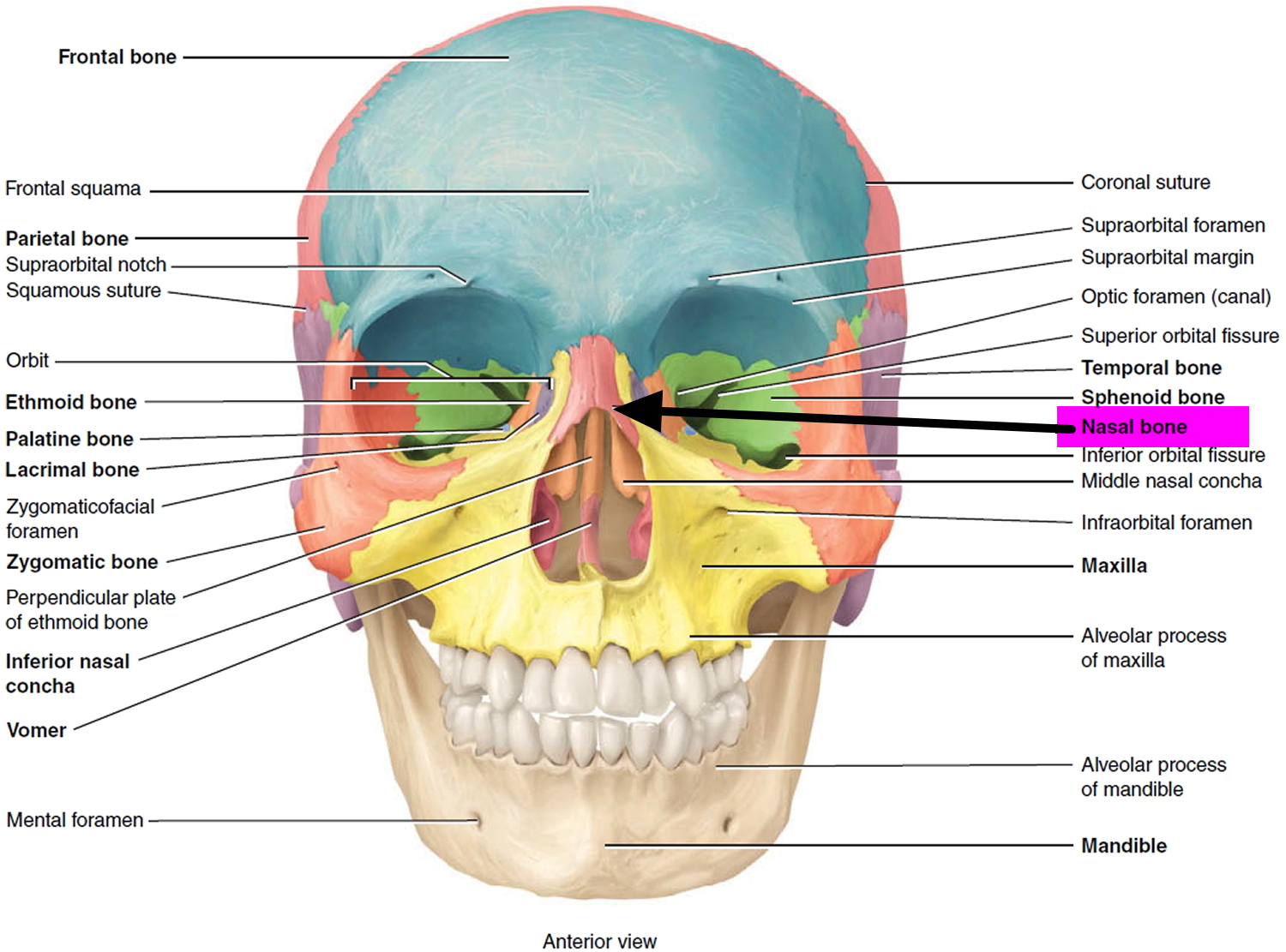
Figure 2. Nasal basic
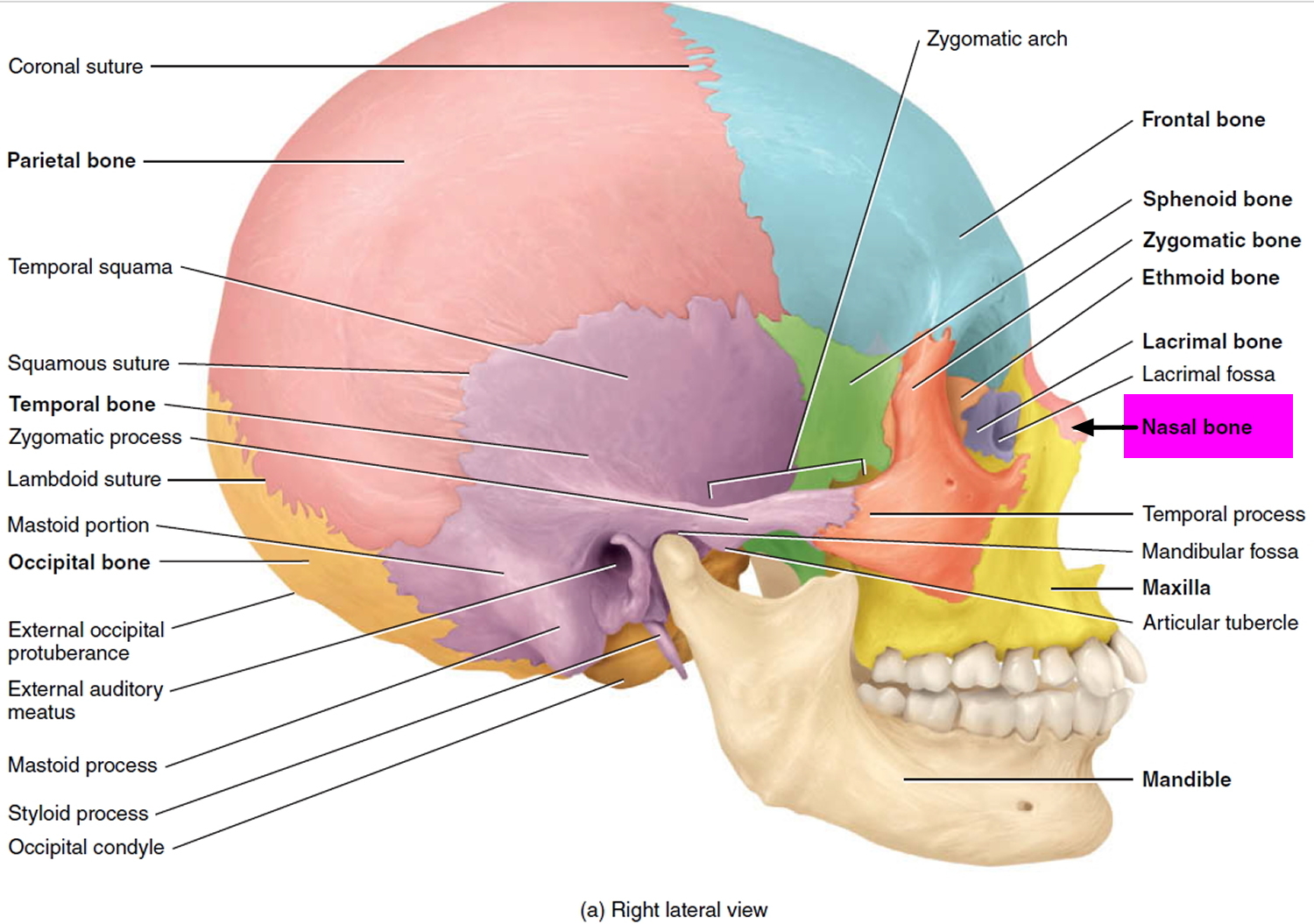 Figure three. Nose cartilage (nasal septum)
Figure three. Nose cartilage (nasal septum)
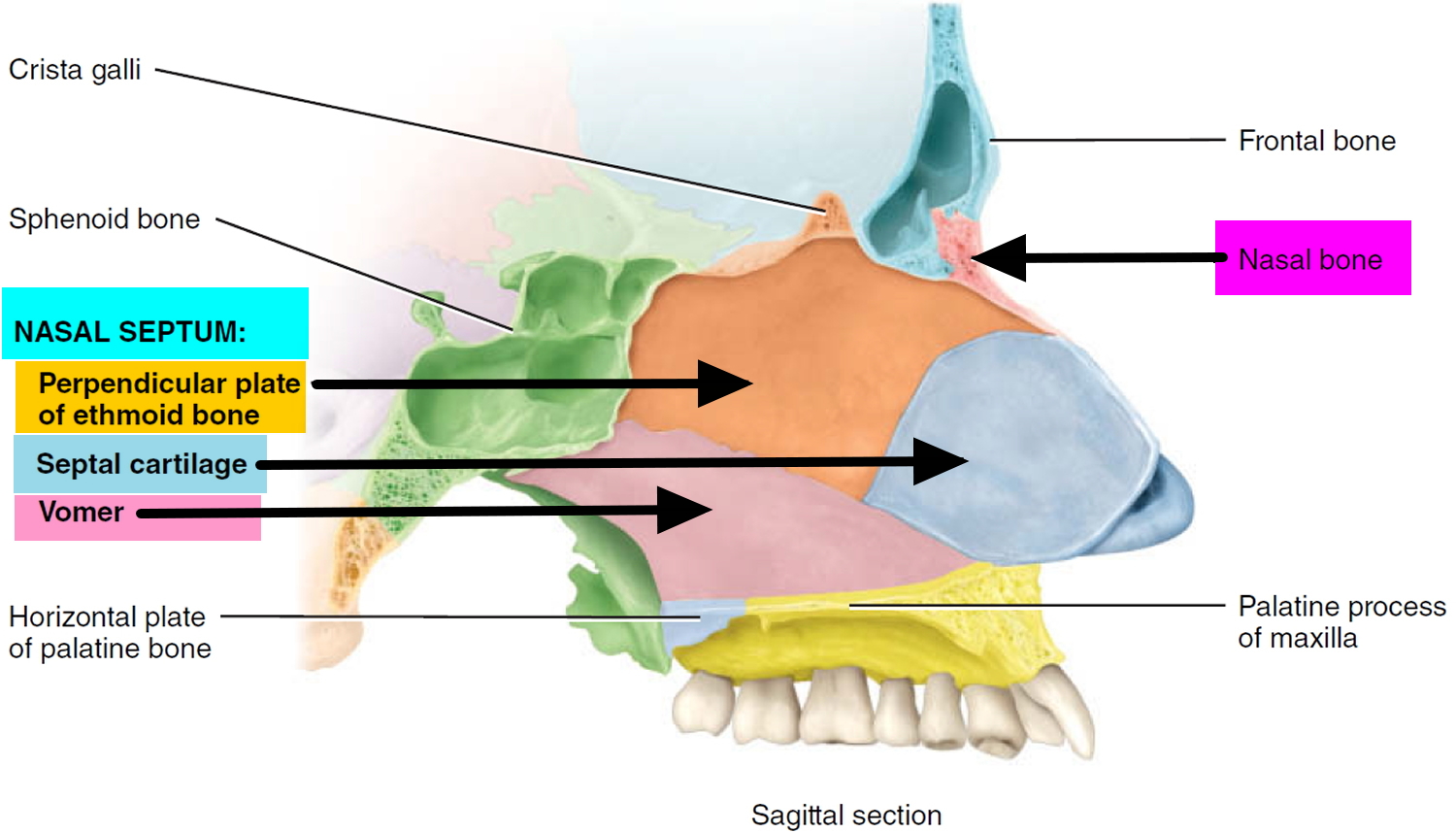 Figure iv. Nose external anatomy
Figure iv. Nose external anatomy
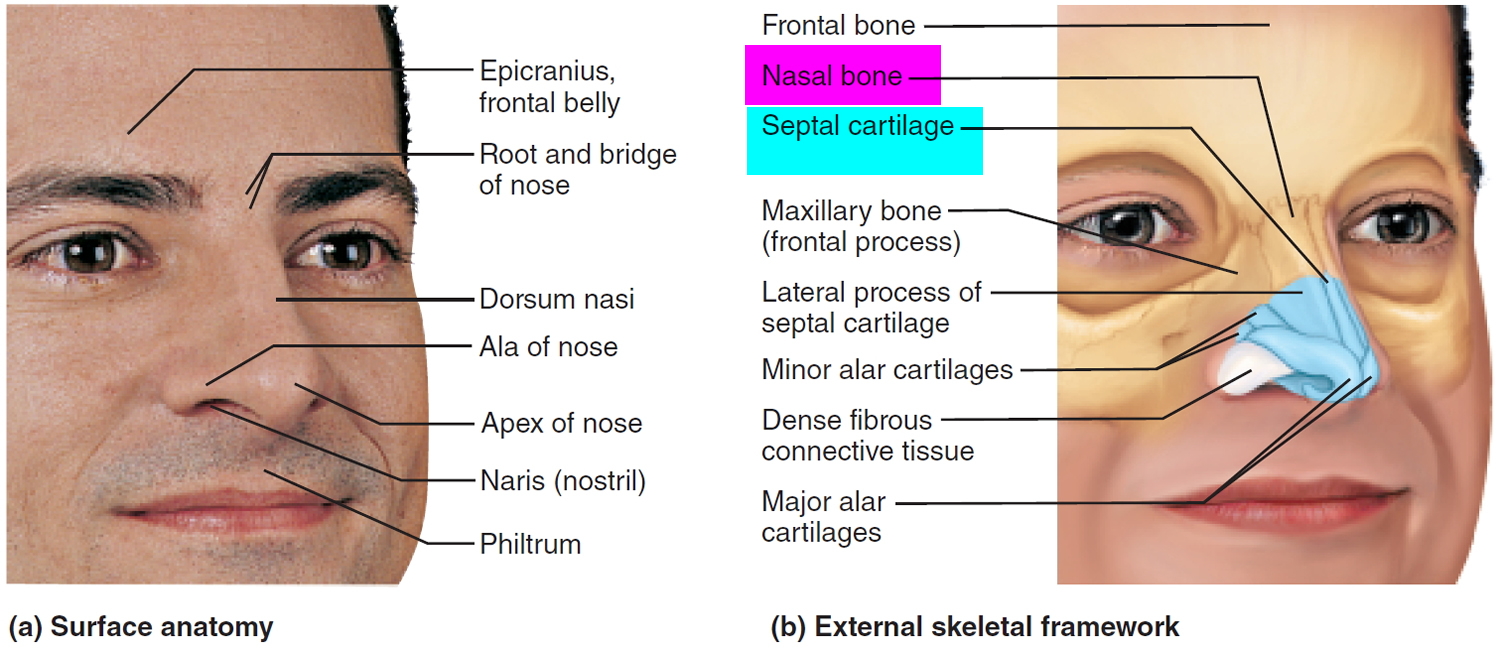
How to tell if your nose is cleaved
Symptoms of a cleaved olfactory organ may include:
- pain, swelling and redness
- a crunching or crackling sound when yous affect your nose
- difficulty breathing out of your nose – it might experience blocked
- your olfactory organ changing shape – for example, it's not every bit straight as before
You may also take:
- Bruising around the eyes (black eyes) (Figure 5)
- A cut on the bridge of the olfactory organ or a nosebleed (Figure half dozen).
Figure v. Signs of a broken nose with bruising around the eyes (black eyes)
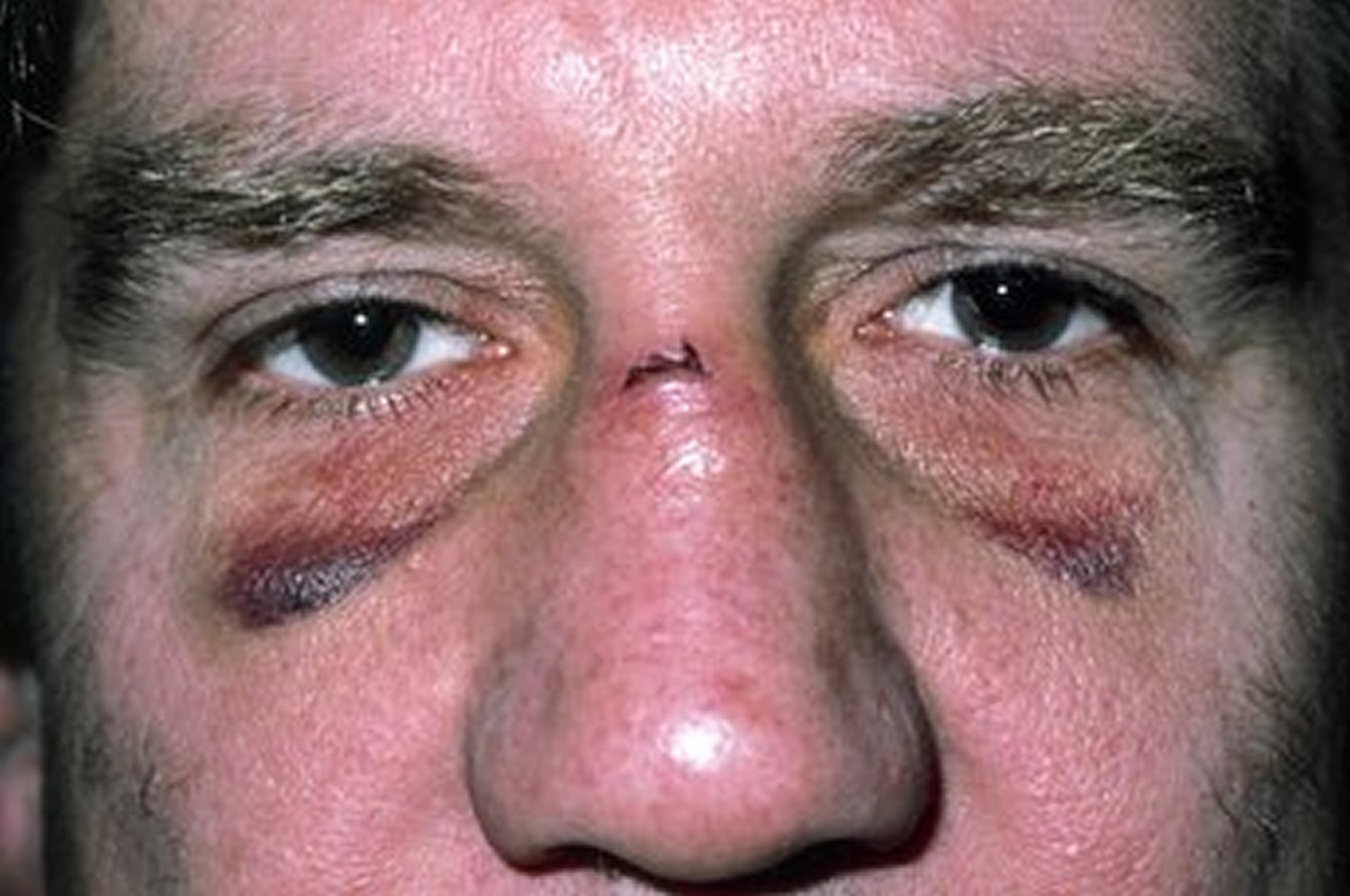
Figure half dozen. Broken nose – annotation a cut on the bridge of the nose or a nosebleed
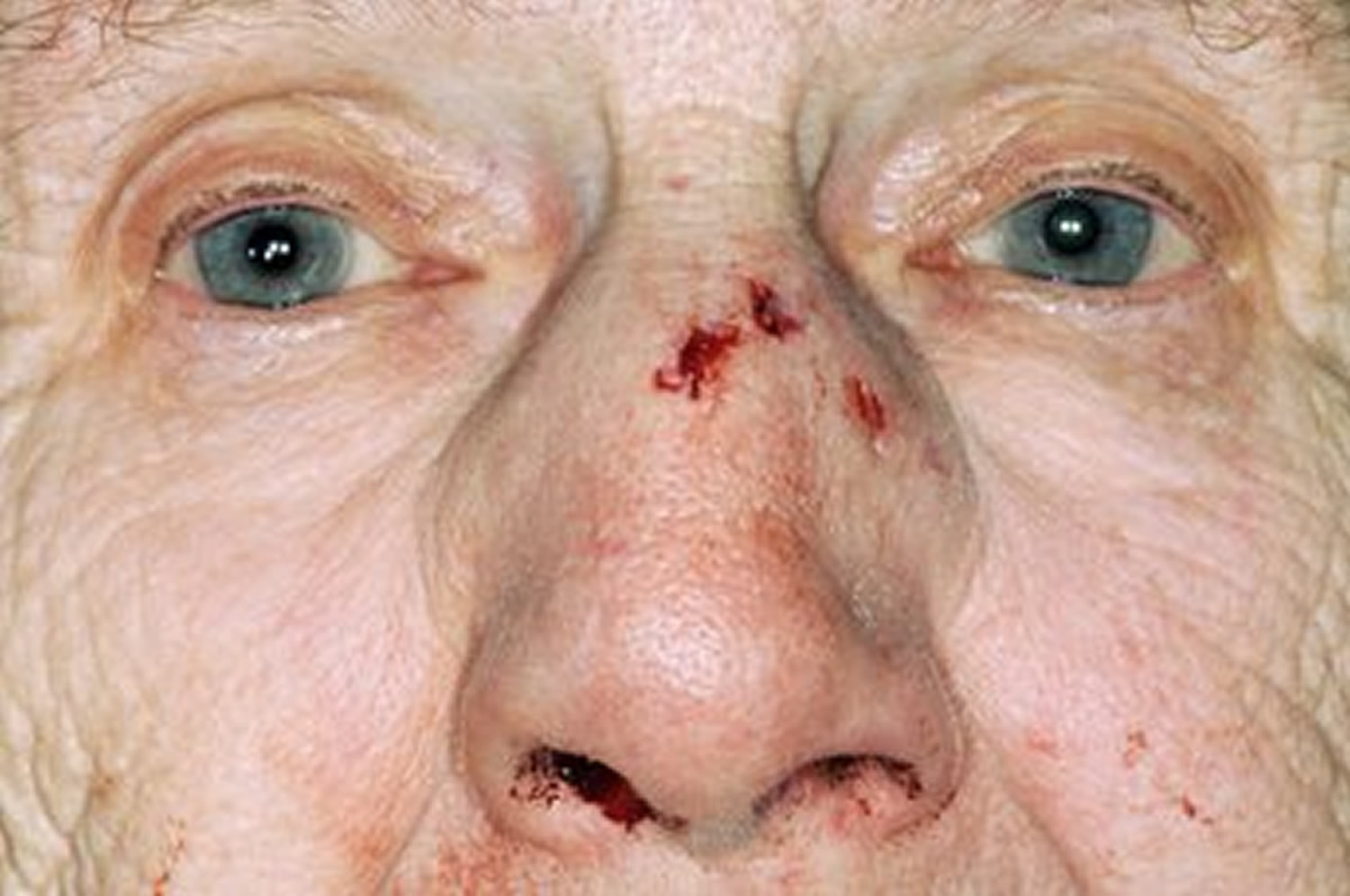
What causes a broken olfactory organ?
Nasal fractures or broken noses, result from facial injuries in contact sports or falls. Injuries affecting the teeth and mouth may also affect the olfactory organ.
Common causes of a broken olfactory organ include:
- Injury from contact sports, such as football or hockey
- Physical altercations
- Motor vehicle accidents
- Falls
A cleaved nose tin can fifty-fifty be caused past walking into a fixed object, such every bit a door or wall, or by rough, wrestling-type play.
Chance factors for a cleaved olfactory organ
Any activeness that increases your risk of a facial injury increases your risk of a cleaved olfactory organ. Such activities may include:
- Playing contact sports, such every bit football game and hockey, especially without a helmet that has a face mask
- Engaging in a physical fight
- Riding a bicycle
- Lifting weights, especially if you don't utilize a spotter
- Riding in a motor vehicle, especially without a seat chugalug
How can I prevent a cleaved nose?
- Wear protective gear to shield your face, such as a helmet with a face mask, when participating in contact sports
- Avoid fist fights
- Wear your seat belt when traveling in a motorized vehicle, and go along children restrained in historic period-advisable child safety seats.
- Wear a helmet during bicycle or motorcycle rides.
Cleaved nose signs and symptoms
Signs and symptoms of a broken nose:
- Pain or tenderness, specially when touching your nose
- Swelling of your nose and on the bridge of your olfactory organ and surrounding areas
- Haemorrhage from your nose
- Bruising effectually your nose or optics
- Crooked or misshapen nose
- Difficulty breathing through your nose
- Belch of mucus from your olfactory organ
- Feeling that one or both of your nasal passages are blocked.
Cleaved nose diagnosis
Your doctor may press gently on the exterior of your nose and its surrounding areas. He or she may look inside your nasal passage to check for obstruction and farther signs of cleaved bones. Your physician may utilize anesthetics — either a nasal spray or local injections — to make you more comfortable during the exam.
X-rays and other imaging studies are normally unnecessary. Notwithstanding, your md may recommend a computerized tomography (CT) scan if the severity of your injuries makes a thorough physical exam incommunicable or if your doctor suspects you may have other injuries.
Broken olfactory organ treatment
Cleaved nose Offset Aid
If you think you lot may have broken your nose, take these steps to reduce pain and swelling before seeing your medico:
- Act quickly. When the interruption first occurs, exhale through your mouth and lean forwards to reduce the amount of blood that drains into your pharynx.
- Utilize ice. Apply ice packs or common cold compresses immediately after the injury, and then at least 4 times a day for the commencement 24 to 48 hours to reduce swelling.
- Keep the ice or cold compress on for 10 to xv minutes at a time. Wrap the water ice in a washcloth to foreclose frostbite. Try not to apply likewise much pressure, which tin can cause additional hurting or damage to your nose.
- Relieve pain. Have over-the-counter pain relievers, such as acetaminophen (Tylenol, others), ibuprofen (Advil, Motrin IB, others) or naproxen sodium (Aleve, others), as necessary.
- Keep your caput upward. Drag your caput — especially when sleeping — and so as not to worsen swelling and throbbing.
- Limit your activities. For the get-go two weeks after handling, don't play whatever sports. Avoid contact sports for at least half dozen weeks after your injury.
How to fix a broken olfactory organ
If your olfactory organ is broken simply non out of position, you lot tin can usually treat a broken nose yourself.
Yous may need no handling other than residual and being careful not to bump your nose.
It should start getting better within iii days and exist fully healed inside 3 weeks.
DO
- concord an ice pack (or frozen peas) wrapped in a tea towel on your nose for up to xv minutes, 2 to 3 times a solar day. DO Non utilize ice directly to the pare.
- take acetaminophen (Tylenol) or ibuprofen (Advil, Motrin), naproxen (Aleve, Naprosyn) to relieve the pain. Yous tin can purchase these pain medicines at the shop.
- treat nosebleeds past sitting or standing upright and leaning forrad – if possible, pinch your olfactory organ to a higher place the nostrils for up to 15 minutes
- go along your head upright when lying in bed by adding more than pillows – this will assist to reduce swelling
- care for minor cuts and grazes – if you have a pocket-size cutting on your olfactory organ.
How to care for cuts and grazes
- Stop the bleeding
Cease any bleeding before applying a dressing to the wound. Apply pressure to the area using a clean and dry absorbent material – such equally a bandage, towel or handkerchief – for several minutes.
- Clean the wound and apply a dressing
When the wound has stopped bleeding, clean it and embrace it with a dressing to help stop it becoming infected.
To do this:
- wash and dry your hands thoroughly
- make clean the wound under drinking-quality running tap water – avoid using antiseptic every bit it may damage the skin and slow healing
- pat the area dry out with a clean towel
- apply a sterile adhesive dressing, such as a plaster – read more about how to utilize plasters and other dressings
Keep the dressing clean by changing information technology as frequently equally necessary. Keep the wound dry by using waterproof dressings, which volition allow you to take showers.
You can remove the dressing after a few days, one time the wound has closed itself.
- Take painkillers if needed
If the wound is painful for the first few days, you can take over-the-counter painkillers such as paracetamol or ibuprofen.
DON'T
- effort to straighten your nose yourself if it's changed shape – come across a medico instead
- wear glasses until the swelling has gone down, unless you need them
- option or blow your nose until it's healed
- do strenuous exercise for the kickoff 2 weeks
- play sports where your face might be hit for at least 6 weeks
When to get medical help
A wound is at risk of infection if:
- it has been contaminated with dirt, pus or other bodily fluids
- there was something in the wound before it was cleaned, such as gravel or a shard of glass
- it has a jagged edge
- it's longer than 5 cm (2 inches)
Signs a wound has become infected include:
- swelling, redness and increasing pain in the affected area
- pus forming in or around the wound
- feeling generally unwell
- a high temperature (fever) of 38 °C (100.4 °F) or above
- swollen glands under the chin or in the cervix
An infected wound tin can normally be successfully treated with a short course of antibiotics.
Treating a severe broken nose in infirmary
If your olfactory organ has changed shape
A doctor in infirmary may be able to make your nose straighter using a procedure chosen manipulation. Manipulation is done using anesthetic so that you're asleep or your olfactory organ is numbed. It doesn't always brand your nose look exactly the same as it was before, but it ofttimes helps. Your medico will reposition the broken bones into place and so hold them in the right location with a "cast" made of plastic, plaster, or metallic. This cast will and so stay in place for a week. In the kickoff two weeks afterwards the injury, your doctor may offer you this kind of repair, or a similar approach using full general anesthesia in the operating room.
Yous might take to become home and await a few days for the swelling to go downwardly, merely the procedure should be done within xiv days for adults and seven days for children from when the fracture occurred, preferably sooner.
If left untreated, a broken nose can exit y'all with an undesirable appearance equally well equally permanent difficulty in trying to exhale.
Manual realignment
If the break has displaced the basic and cartilage in your nose, your physician may be able to manually realign them.
During this process, your doctor:
- Administers medication by injection or nasal spray to ease discomfort
- Opens your nostrils with a nasal speculum
- Uses special instruments to assist realign your broken basic and cartilage
Your dr. will also splint your nose using packing in your olfactory organ and a dressing on the outside. Sometimes, an internal splint is also necessary for a curt time. The packing usually needs to stay in for a week. You lot'll also exist given a prescription for antibiotics to prevent infection with the bacteria that may normally reside in your nose.
If you have a large wound
The wound will normally exist cleaned and sealed with stitches or strips in hospital.
If your nose won't terminate bleeding
A doctor may identify a soft gauze pad in your olfactory organ. The pad will be removed by the doctor a few days after.
If you lot have a septal hematoma
This is a drove of claret within the septum of the olfactory organ. The septum is the part of the olfactory organ between the 2 nostrils. An injury disrupts the blood vessels so that fluid and claret may collect under the lining. Your provider may have made a modest cut to drain the blood.. Sometimes, pools of clotted blood form in a broken nose, creating a condition chosen a septal hematoma. A septal hematoma can block one or both nostrils. Septal hematoma requires prompt surgical drainage to forestall cartilage damage.
Broken olfactory organ surgery
Severe breaks, multiple breaks or breaks that accept gone untreated for more than 14 days may non exist candidates for manual realignment. In these cases, surgery to realign the basic and reshape your nose may be necessary.
If the break has damaged your nasal septum, causing obstruction or difficulty breathing, reconstructive surgery may be recommended. Surgery is typically performed on an outpatient ground.
If more two weeks have passed since the time of your injury, y'all may demand to wait a while before having your olfactory organ straightened surgically. It may exist necessary to await two to three months before a good repair can be done, by which time there volition be less swelling and your olfactory organ will have begun to heal. Reduced swelling will allow the surgeon to get a more accurate picture of how your nose originally looked. This type of surgery is considered reconstructive plastic surgery, as its goal is to restore your appearance to the way it was prior to injury. If your repair is washed within two weeks of the injury, restoring prior appearance is the only possible goal. If yous have waited several months for the repair, it is often possible to change the appearance of your olfactory organ as you desire. Should you be interested in this kind of advent modify equally well as repair, you tin feel confident that your plastic surgeon or an ear, nose, and throat doctor is a specialist in all surgery of the nose. No other specialty has more preparation in surgery on the nose, and some plastic surgeon or an ear, nose, and throat doctor focus exclusively on plastic surgery of the face.
Source: https://healthjade.com/broken-nose/
0 Response to "How Do You Know if Child Broken Nose"
Post a Comment